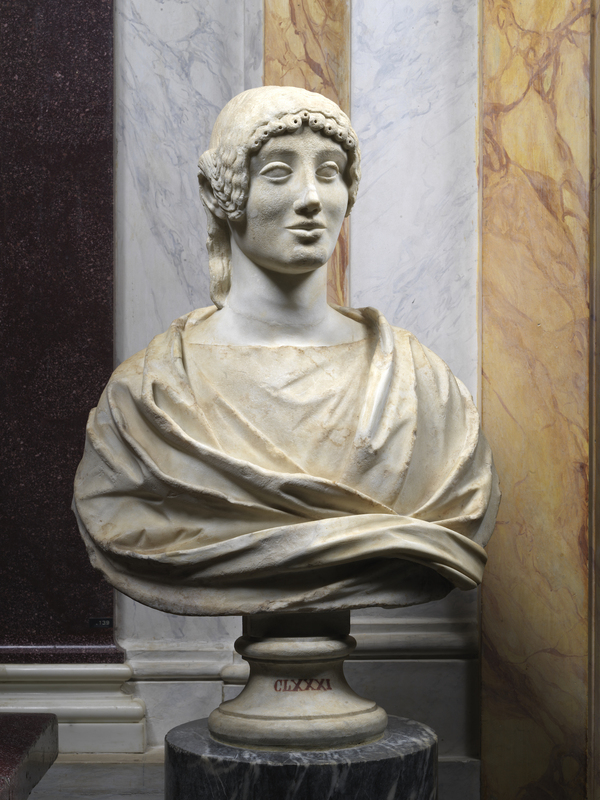Head of a Kore, on a modern bust
This head depicts a young woman with clearly defined features, large, almond-shaped eyes, small, lips and elegantly arranged hair. Her long locks are gathered to the sides of her face and into a braid behind her head, while her forehead is framed by small ringlets that must have been originally embellished with bronze or gold applique. The sculpture seems in the severe style of the fifth century BCE, produced in Magna Graecia. According to Helbig, it was discovered during excavations carried out in 1834 at the port of Anzio. In 1893, it was mentioned in the sixth room of the Palazzina Borghese.
Object details
Inventory
Location
Date
Classification
Medium
Dimensions
height with bust 59 cm; head height 25 cm
Provenance
Borghese Collection, mentioned in 1893 in the sixth room by Venturi (p. 37). Purchased by the Italian State, 1902.
Conservation and Diagnostic
- 1996-97 - Liana Persichelli
Commentary
According to Helbig, this head is the one that was found at the port of Anzio in 1834 (p. 107; Lanciani 1994, p. 34). In 1893, Venturi mentioned it in the sixth room of the Palazzina Borghese, describing it as a ‘busto di donna. Ritratto arcaico greco (del secolo VI a.C.) innestato su un busto moderno’ (‘bust of a woman. Archaic Greek portrait [sixth century BCE] set on a modern bust’; p. 37).
The head of a young woman, in a rigid style, is set on a modern bust. Her hair is elaborately arranged in long wavy locks rendered with deep furrows that fall along her neck in the back. In the front, these locks are arranged in a soft curve above her ears, which are uncovered, and gathered into a braid in the back. Her forehead is framed by a row of small, symmetrical, tight ringlets pierced with a drill in the middle. The holes probably indicate that the ringlets were originally embellished with bronze or gilt curls. Her eyes are almond-shaped, with large, heavy lids, her eyebrows are barely indicated, and she has high cheekbones. Her mouth is small, with a thin upper lip and a fuller lower one. The head is unanimously recognised as in the severe style, datable to the early fifth century BCE and from Magna Graecia. Considering the characterisation of the face, Helbig saw it as a portrait, whereas Fuchs considered it instead a depiction of Nike (1913, p. 245, no. 1551; 1966, pp. 325–326, no. 1509). Similar features and the insertion of metal decoration are also found in a colossal exemplar of the same subject in the Collezione Ludovisi, now in the Museo Nazionale Romano, Palazzo Altemps and believed to have been produced in the same region (Palma 1983, pp. 130–133).
Giulia Ciccarello
Bibliography
- A. Venturi, Il Museo e la Galleria Borghese, Roma 1893, p. 37.
- P. Arndt, F. Bruckmann, Griechische und römische Porträts, II, Brunn 1910, tavv. 211-212.
- L. C., Scavi dell’Inviolatella, di Acquatraversa e di Nettuno, in “Bullettino dell’Instituto di Corrispondenza Archeologica”, 1834, pp. 104-108, in part. p. 107.
- W. Helbig, Führer durch die öffentlichen Sammlungen klassischer Altertümer in Rom (3° Edizione), a cura di W. Amelung, II, Leipzig 1913, p. 245, n. 551.
- G. Giusti, The Borghese Gallery and the Villa Umberto I in Rome, Città di Castello 1919, p. 41.
- A. De Rinaldis, La R. Galleria Borghese in Roma, Roma 1935, p. 14.
- P. Della Pergola, La Galleria Borghese in Roma, (3° Edizione), Roma 1954, p. 17.
- R. Calza, Catalogo del Gabinetto fotografico Nazionale, Galleria Borghese, Collezione degli oggetti antichi, Roma 1957, p. 7, n. 1.
- W. Helbig, H. Speier, Führer durch die öffentlichen Sammlungen klassischer Altertümer in Rom, (4°Edizione), a cura di H. Speier, II, Tübingen 1966, p. 325, n. 1501; p. 736, n. 1981 (Fuchs).
- P. Moreno, Museo e Galleria Borghese, La collezione archeologica, Roma 1980, p. 17, fig. 33.
- R. Tölle Kastenbein, Frühklassische Peplosfiguren, Originale, Mainz am Rhein 1980, p. 200, nota 385.
- P. Moreno, S. Staccioli, Le collezioni della Galleria Borghese, Milano 1981, p.100, fig. 64.
- B. Palma, Acrolito Ludovisi, in Museo Nazionale Romano. Le sculture, I, 5, Roma 1983, pp. 130-133.
- R. Lanciani, Storia degli scavi di Roma e notizie intorno le collezioni romane di antichità, V, Roma 1994, p. 34.
- P. Moreno, C. Stefani, Galleria Borghese, Milano 2000, p. 151, n. 16.
- P. Moreno, A. Viacava, I marmi antichi della Galleria Borghese. La collezione archeologica di Camillo e Francesco Borghese, Roma 2003, p. 77, n. 24.
- Schede di catalogo 12/99000406, G. Ciccarello 2020.





